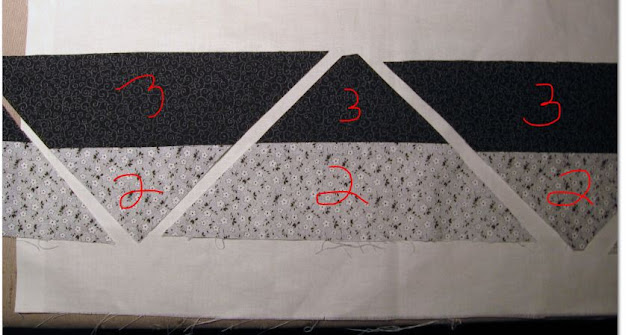Taking some time to finish a quilt I began a couple of years ago (oh, horrors !!). This is one of those projects I had started with great enthusiasm and had made some real progress and then forgotten about in the midst of day to day work , etc. I was inspired by a quilting show I had seen where they featured strip quilting. I have used the strip-quilt method before, but usually for a log cabin pattern. I wanted to do a design using triangles where little if anything was wasted when cutting the strips to make a pattern. Over the next while I was thinking about a home for the quilt I wanted to finish "someday". I don't really need it and wanted to give it to a worthy cause. Well, I now have one. There is a 10-year old boy in my area fighting an aggressive form of brain cancer and they are having an auction this month (April) to help the family pay for medical expenses. That is a match made in heaven ! I now have a great desire to finish the quilt and am so happy it will have a place to go.
This is what I have so far. The rest will be repetition of these patterns for the most part.
There are 6 different fabrics used in this quilt. It's mostly a monochromatic look with a couple of darks thrown in for effect. Each strip is cut 3" wide and sets of 2 strips (according to pattern) are sewn together- lengthwise and then cut into triangles. There are a couple of places where there are 3 strips sewn together. This is necessary to make the blocks square. The fabrics represent 1 to 6 from left to right in the photo below.
Below is the basic layout of the whole quilt, but I might need to do some half-blocks or extra borders to make
the finished dimensions correct, since this is basically square.
Starting with the center block (outlined in blue above), I am using all 6 fabrics as shown in the diagram below. I have drawn lines to show where the triangles are. So, for the center block I am sewing together strips of fabrics # 1 and # 3, #2 and #3, #3 and #4, and #3,#5 and #6 ( the only 3-strip triangle in this block).
After the strips are sewn together the triangles need to be cut. The base of the trangle is about 11.5 inches . The height is about 5.5 inches at the point. When you cut the triangles, for example, with the #3 fabric at the top point, you have left, the opposite triangles with the #3 at the bottom. Those, as well as the other "opposite" triangles, I am using in the other surrounding blocks or borders around the entire quilt
Strips for the second block are sewn together as follows: fabrics # 2 and #3,# 3 and #4 and #2,#3 and #5. I would suggest sewing the #5 fabric on after cutting the 2-strip triangle of fabrics #2 and #3. Otherwise you will get all of those "opposite" 3-strip triangles that may not have a home and will cause more waste.
From the example of fabrics #2 and #3 in the photo above the triangles with the #2 fabric at the point of the triangle and the #3 fabric at the bottom are used in the blocks surrounding the center block. These are outlined in blue in the photo below. Actually there will be a third strip of #5 fabric (mentioned above) sewn to this triangle to complete the size needed to fill out the large square block.
As for piecing the triangles together, I can give more information to anyone who is interested, but as a general rule, you want to sew in straight lines whenever possible. That means you sew triangles into squares or rectangles or larger triangles and then sew those pieces together. The back side of the pieced quilt below, may give you an idea of how you can do this.
This is probably a bit confusing to beginners, but for you avid quilters.....it should give you a pretty good idea of what I am up to. I will hopefully add more details about my progress as time permits. If anyone is interested in more details about construction of the quilt or the pattern idea, I would be
very happy to share as best as I can. I will admit it was a sort of fly-by-the-seat-of-your-pants design. But I will do my best to explain or answer questions. Just contact me by email : lynettelwilliams@gmail.com
Hope it inspires you to strip quilt. It really is a very versatile way to make quilts quite fast !
Have fun !!
LW




















